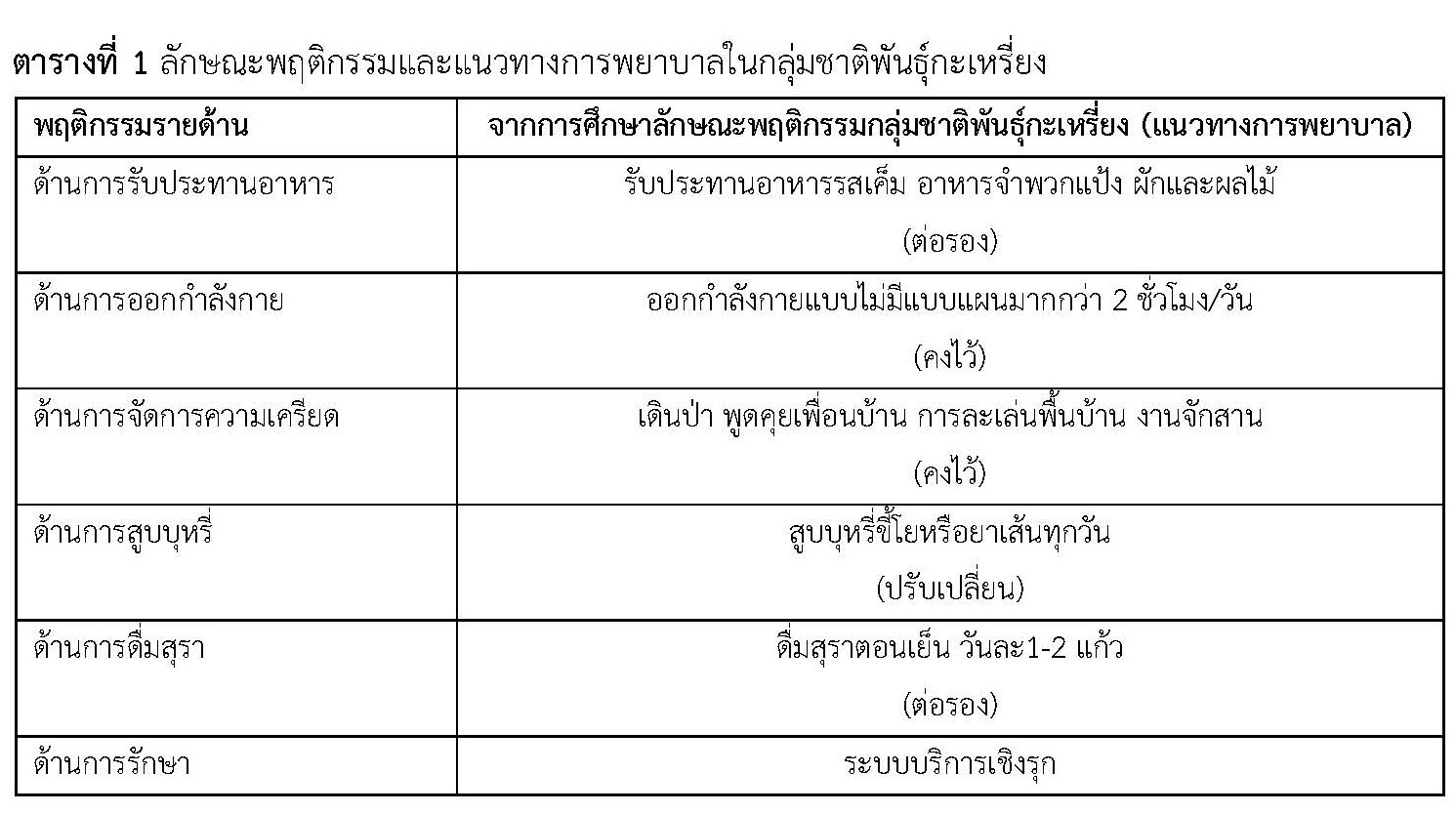Caring for Non-Communicable Diseases among the Karen Ethnic Group with Cultural Differences: Nurse’s Roles
Keywords:
Non-Communicable Diseases, Karen, Cultural Differences, Nurse’s RolesAbstract
In Thailand, there is diversity in ethnicities. One of the largest ethnic groups is the Karen ethnic group, which primarily resides in highland or mountainous areas of Thailand, especially in the provinces of Chiang Mai, Chiang Rai, and Tak. They have their own language, beliefs, wisdom, customs, and culture, leading to a distinctive way of life compared to Thai people living in flat areas. Over the past 5 years, the Karen ethnic group has seen an increase in the incidence of non-communicable chronic diseases. The objective of this academic article is to present the role of nurses in providing culturally appropriate health care for ethnic groups with diverse lifestyles. This aims to align nursing practices with cultural behaviors regarding dietary habits, physical activity, stress management, alcohol and tobacco consumption, and health service systems, impacting the healthcare of patients with non-communicable chronic diseases within ethnic groups. It adheres to the culturally congruent nursing care of the "Sunrise Model," based on the concept of Leininger (2002), and uses this framework to guide nurses in decision-making for selecting appropriate nursing interventions. These interventions include: 1) preserving care, 2) negotiating with the healthcare team regarding treatment, and 3) making overall nursing adaptations. This facilitates a nursing process that helps patients adapt their lifestyles to conform to the healthcare model established by the healthcare team.
References
กระทรวงสาธารณสุข. (2566). ความดันโลหิตสูงที่ขึ้นทะเบียนได้รับการประเมินโอกาสเสี่ยงต่อโรคหัวใจและหลอดเลือด 2561-2565. สืบค้นเมื่อ 19 กรกฎาคม 2566 จาก https://shorturl.asia/u4lP3.
กลุ่มกิจการชาวเขา. (2559). ทำเนียบชุมชนบนพื้นที่สูง กรมพัฒนาสังคมและสวัสดิการ. เชียงราย: พริ้นเชียงรายจำกัด.
ฐิตารัตน์ สารกองแดง และกลีบแก้ว จันทร์หงส์. (2563). บทบาทของพยาบาลเวชปฏิบัติในการดูแลผู้ป่วยโรคไม่ติดต่อเรื้อรังในชุมชน. วารสารวิจัยสุขภาพและการพยาบาล, 36(3), 317-327.
ณงค์ณุช นทีพายัพทิศ. (2557). อัตลักษณ์ผ้าทอกะเหรี่ยงปกาเกอะญอ. วารสารการพัฒนาชุมชนและคุณภาพชีวิต, 2(1), 113-121.
ณัจฉรีญา จิตจักร. (2562). พฤติกรรมเสี่ยงต่อโรคความดันโลหิตสูงในชนเผ่าปกาเกอะญอ อำเภอแม่แจ่ม จังหวัดเชียงใหม่. ลำปางเวชสาร, 40(1), 10-16.
ทวีศักดิ์ กิตฺติญาโณ. (2561). การเปลี่ยนแปลงวิถีชีวิตของชุมชนกะเหรี่ยง บ้านพระบาทห้วยต้ม ตำบลนาทราย อำเภอลี้ จังหวัดลำพูน. วารสารปัญญา, 25(1), 51-63.
ทัศนีย์ จินะธรรม, ภิรภัทร คุ้มเนตร และพิษณุรักษ์ กันทวี. (2561). การศึกษาความเชื่อ และพฤติกรรมด้านสุขภาพที่มีผลต่อการป้องกันการเกิดโรคเบาหวานในกลุ่มชนชาติพันธุ์กะเหรี่ยง อำเภอดอยหลวง จังหวัดเชียงราย. เชียงรายเวชสาร, 10(1), 179-192.
ธนพงศ์ ภูผาลี, ชิดชนก คูณสวสัดิ์, ธนิตา ภูราชพล และธารินี ศรีศักดิ์นอก. (2560). คำอธิบายถึงการมียาเหลือใช้และพฤติกรรมในการจัดการยาเหลือใช้ของผู้ป่วยโรคเบาหวานและโรคความดันโลหิตสูง: กรณีศึกษาในชุมชนแห่งหนึ่งของจังหวัดอุบลราชธานี. วารสารเภสัชกรรมไทย, 10(1), 5-12.
นพรัตน์ ธนะชัยขันธ์. (2543). ความก้าวหน้าในการรักษาโรคหลอดเลือดหัวใจตีบ. เอกสารประกอบการประชุมวิชาการเรื่อง การพยาบาลผู้ป่วยโรคหัวใจ และหลอดเลือดปี 2000 ณ พันตน โรงแรมโลตัสปางสวนแก้ว เชียงใหม่.
ปรารถนา ลังการ์พินธุ์. (2563). การดูแลสุขภาพแบบต่างวัฒนธรรมในยุคดิจิทัลดิสรัปชั่น. วารสารสมาคมพยาบาลแห่งประเทศไทยฯ สาขาภาคเหนือ, 26(2), 67-77.
ปิ่นทอง ผึ้งดอกไม้, วิชชุดา เจริญกิจการ, วันเพ็ญ ภิญโญภาสกุล, ศรินรัตน์ ศรีประสงค์ และฉัตรกนก ทุมวิภาต. (2559). ปัจจัยที่มีอิทธิพลต่อความร่วมมือในการรับประทานยาในผู้ป่วยโรคความดันโลหิตสูงที่ยังไม่มีภาวะแทรกซ้อน. วารสารมหาวิทยาลัยนราธิวาสราชนครินทร์, 8(1), 16-26.
อรวรรณ สัมภวมานะ, ลินดา คล้ายปักษี, พนิดา อาวุธ และโศรตรีย์ แพน้อย. (2560). การพัฒนาการจัดการระบบการดูแลผู้ป่วยโรคเรื้อรังของโรงพยาบาลส่งเสริมสุขภาพตำบล : กรณีศึกษา โรงพยาบาลส่งเสริมสุขภาพตำบลมะลวน อ.พุนพิน จ.สุราษฏร์ธานี. วารสารกระทรวงสาธารณสุข, 27(1), 157-167.
วัชรินทร์ คำสา, วรรณรัตน์ ลาวัง และสมสมัย รัตนกรีฑากุล. (2564). ปัจจัยที่มีอิทธิพลต่อพฤติกรรมการป้องกันโรค หลอดเลือดหัวใจในกลุ่มชาติพันธุ์กะเหรี่ยงที่เป็นกลุ่มเสี่ยงในจังหวัดตาก. วารสารคณะพยาบาลศาสตร์ มหาวิทยาลัยบูรพา, 29(3), 76-89.
ศูนย์อนามัยกลุ่มชาติพันธุ์ ชายขอบ และแรงงานข้ามชาติ. (2566). ประวัติศูนย์อนามัยกลุ่มชาติพันธุ์. สืบค้นเมื่อ 19 กรกฎาคม 2566 จาก https://hhdc.anamai.moph.go.th/th.
สมพร รุ่งเรืองกลกิจ, อิงคฏา โคตนารา, รัชฎาพร ธรรมน้อย, อรพิน ยอดกลาง และบุษบา อนุศักดิ์. (2556). ประสบการณ์การพยายามฆ่าตัวตาย: ความแตกต่างทางเพศภาวะ. วารสารสมาคมจิตแพทย์แห่งประเทศไทย, 58(3), 245-256.
สำนักงานคณะกรรมการส่งเสริมวิทยาศาสตร์ วิจัยและนวัตกรรม. (2564). ความหลากหลายทางชาติพันธุ์.ปทุมธานี: เอ-พลัส พริ้น.
สำนักงานสาธารณสุขจังหวัดตาก. (2566). สาเหตุการป่วย 10 อันดับแรก 2561-2565. สืบค้นเมื่อ 19 กรกฎาคม 2566 จาก https://shorturl.asia/DM9Yd.
Enas, A. (2019). Lipoprotein(a): An independent, genetic, and causal factor for cardiovascular disease and acute myocardial infarction. Indian Heart Journal, 71(3), 99-112.
Jingjing, G. & Onkam, I. (2021). Way of life of Hmong ethnic group: A case study of Ban Mae Sa Mai, Pongyang sub-district, Maerim district, Chiang Mai. Liberal Arts Review. 16(1), 27-44.
Leininger, M. (2002). Culture care theory: A major contribution to advance transcultural nursing knowledge and practices. Journal of Transcultural Nursing, 13(3), 189-192. https://doi.org/10.1177/10459602013003005
Lorga, T., Aung, M. N., Naunboonruang, P., Junlapeeya, P., & Payaprom, A. (2013). Knowledge of communicable and noncommunicable diseases among Karen ethnic high school students in rural Thasongyang, the far northwest of Thailand. International Journal of General Medicine, 6, 519-526. https://doi.org/10.2147/ijgm.s44902
Patel, J., et al. (2017). Ethnic Groups Living in The Us the Mediators of Atherosclerosis in South Asians Living in America (MASALA) Study and The Multi-Ethnic Study of Atherosclerosis (MESA). Journal of the American College of Cardiology, 69(11S), 1555-1555.
World Health Organization. (2018). World Health Statistics 2018. Retrieved July 18, 2023 form https://iris.who.int/bitstream/handle/10665/272596/9789241565585-eng.pdf?ua=1.

Downloads
Published
How to Cite
Issue
Section
License
Copyright (c) 2024 Journal of Nursing and Public Health Research

This work is licensed under a Creative Commons Attribution-NonCommercial-NoDerivatives 4.0 International License.
1. บทความหรือข้อคิดเห็นใด ๆ ที่ปรากฏในวารสารวิจัยการพยาบาลและการสาธารณสุข ที่เป็นวรรณกรรมของผู้เขียน บรรณาธิการไม่จำเป็นต้องเห็นด้วย
2. บทความที่ได้รับการตีพิมพ์ถือเป็นลิขสิทธิ์ของ วารสารวิจัยการพยาบาลและการสาธารณสุข








